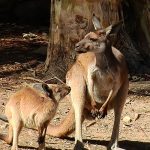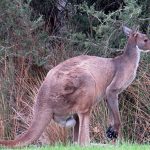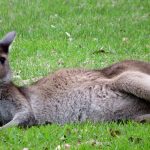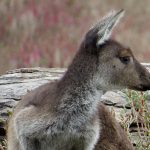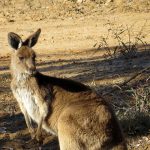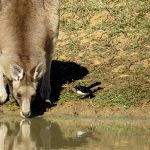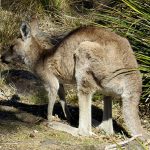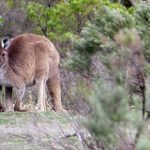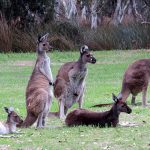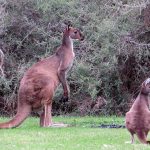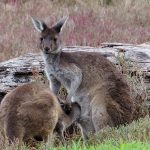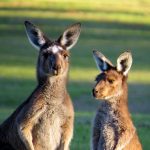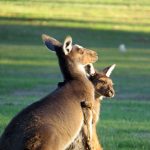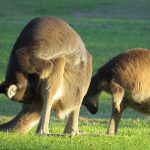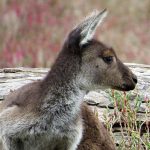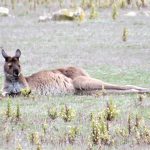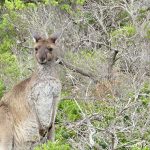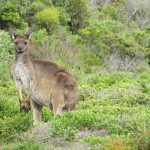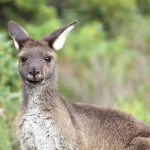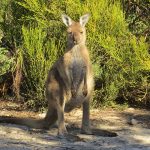WESTERN GREY KANGAROO
The Western Grey Kangaroo: An Australian Icon
In the gentle light of dawn, when the air is cool and the landscape shimmers with dew, a group of Western Grey Kangaroos moves quietly across the open grasslands. Their sturdy forms blend seamlessly with the muted greens and browns of their surroundings, a living testament to adaptation and resilience in Australia’s wild heart.
Physical Description
The Western Grey Kangaroo is a robust marsupial, easily recognised by its:
- Size Difference:
- Adult males can stand up to 1.3 metres tall and weigh as much as 54 kilograms.
- Females are more delicate, averaging around 28 kilograms.
- Fur:
- Their coats are typically grey or brownish-grey, providing excellent camouflage among grasses and trees.
- Fur colour may subtly vary between individuals, reflecting their local habitat.
Range and Habitat
These kangaroos roam widely across southern and western Australia, including:
- Western Australia
- South Australia
- Parts of Victoria and New South Wales
They inhabit a diverse range of environments:
| Habitat Type | Description |
|---|---|
| Open Grasslands | Wide, sunlit spaces rich in grasses |
| Woodlands | Areas with scattered trees, dappled shade |
| Shrublands | Dense, low vegetation offering shelter |
Listen closely in the early morning, and you might hear the soft thud of their powerful feet moving through dew-damp grass or the gentle rustle as they browse quietly beneath eucalyptus trees.
Diet and Feeding Behaviour
Western Grey Kangaroos are herbivores, thriving on:
- Grasses
- Herbs
- Leaves
- Shrubs
Their specialised digestive system acts much like a natural recycling plant, breaking down tough, fibrous plant material to extract maximum nutrition. On warm breezes, the scent of crushed grass often lingers where mobs have recently grazed.
Social Structure and Daily Life
These kangaroos are social animals:
- Live in groups called mobs, ranging from a handful to over 50 individuals.
- Most active during early morning and late afternoon, when temperatures are cooler and light is soft.
- During the heat of the day, mobs rest in the shade of trees or shrubs, their bodies still and ears flicking to catch the faintest sounds.
A typical mob scene is a blend of gentle movement and stillness, with joeys peering cautiously from their mothers’ pouches and older kangaroos grazing or grooming each other.
Reproduction and Lifecycle
As marsupials, Western Grey Kangaroo mothers have a remarkable way of caring for their young:
- Gestation lasts about one month.
- A tiny, undeveloped joey is born and makes its way into the pouch, where it continues to grow for several months.
- As it matures, the joey spends more time outside the pouch, gradually gaining independence.
This close bond between mother and joey is a touching example of nature’s ingenuity and care.
Conservation Status and Human Interaction
| Status | Details |
|---|---|
| IUCN Listing | Least Concern |
| Population Trend | Stable |
| Adaptability | Often seen in rural, suburban, and even some urban environments |
Western Grey Kangaroos are sometimes sighted on golf courses or in parks, their presence a reminder of nature’s persistence even near human habitation. However, their grazing can occasionally bring them into conflict with farmers, highlighting the delicate balance between wildlife and human needs.
Conservation Message
While the Western Grey Kangaroo is currently thriving, its story encourages us to reflect on our relationship with the natural world. By understanding and respecting these iconic animals, we foster a deeper appreciation for Australia’s unique biodiversity and the importance of preserving habitats for future generations.
Conclusion
The Western Grey Kangaroo is not just a symbol of Australia—it is a living, breathing participant in the continent’s ongoing story. From the soft patter of feet through morning grass to the quiet bond between mother and joey, every detail invites us to look closer, listen more intently, and cherish the wild places that still remain.
Did you know?
Western Grey Kangaroos are sometimes called the “stinker” because of the strong, curry-like odour that males can emit—a unique adaptation among kangaroos!
Let’s celebrate and protect these remarkable creatures, ensuring their story continues for generations to come.

